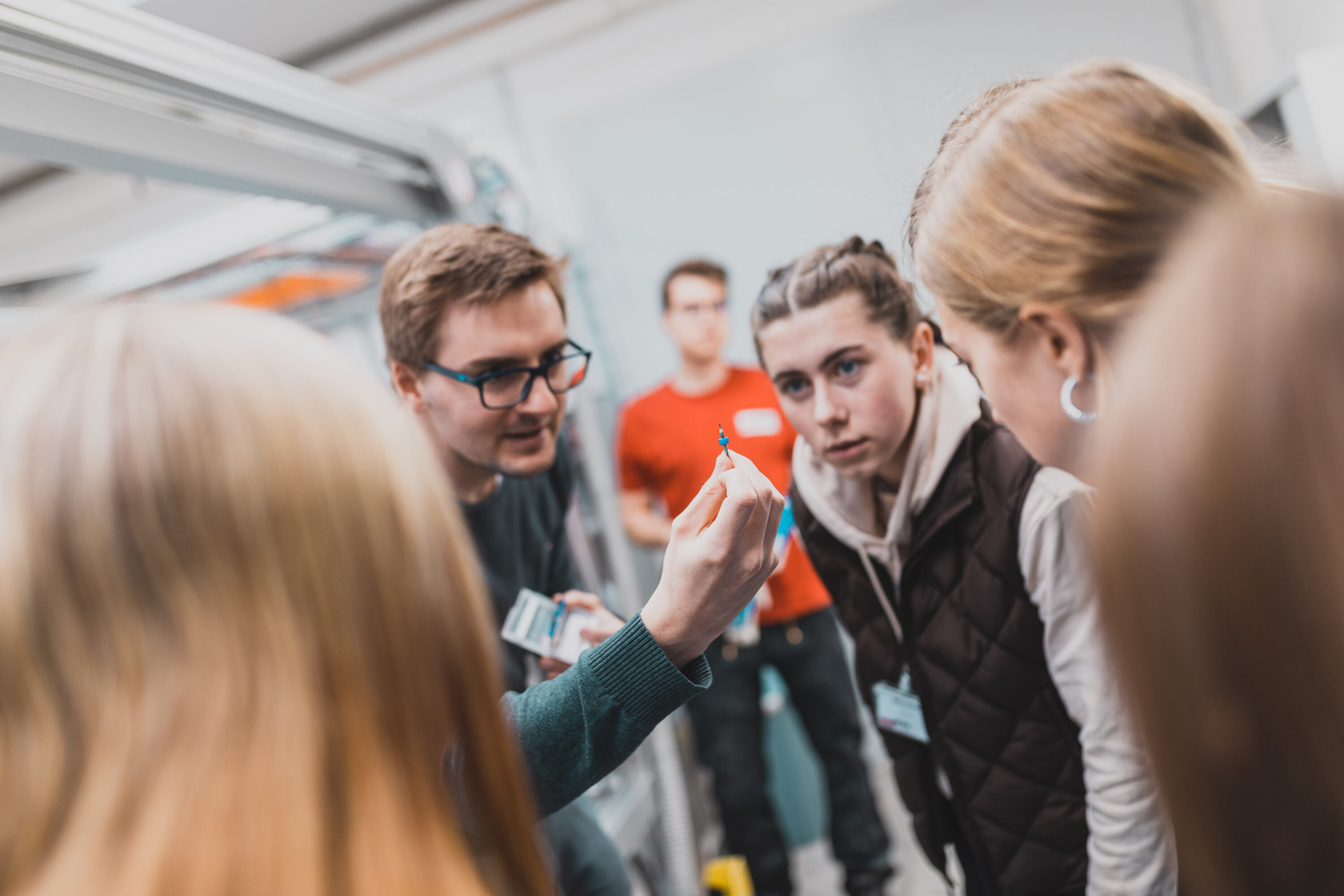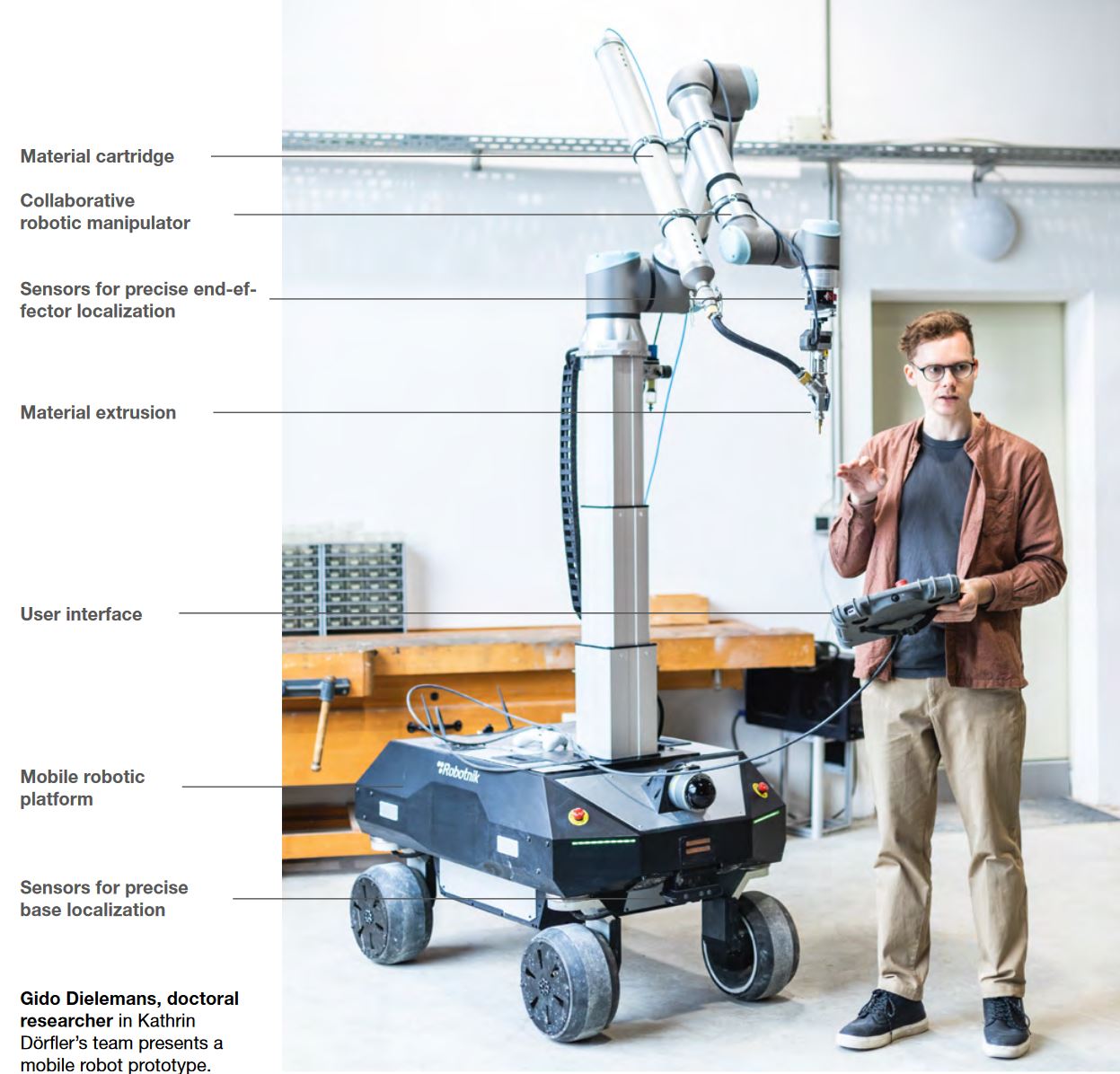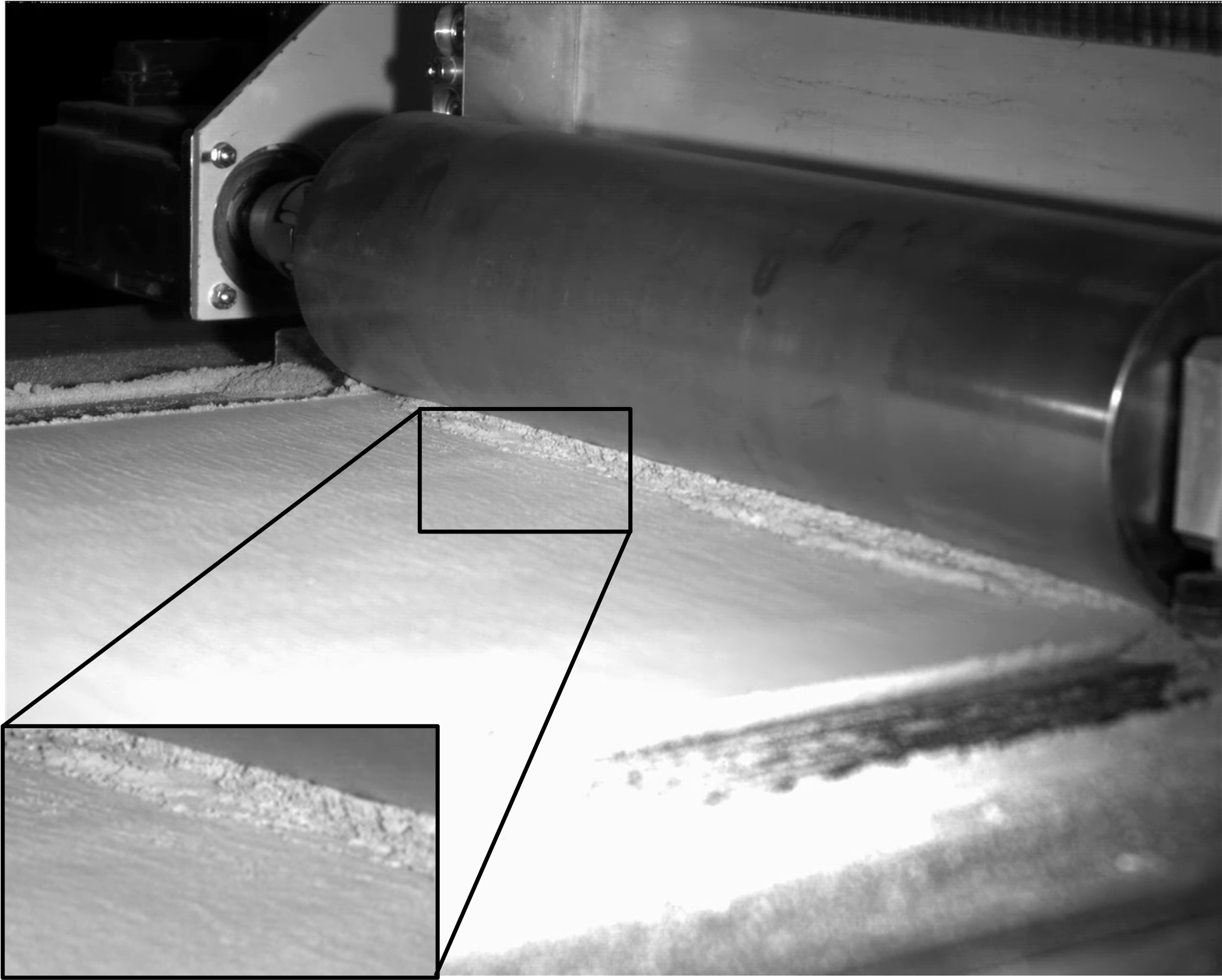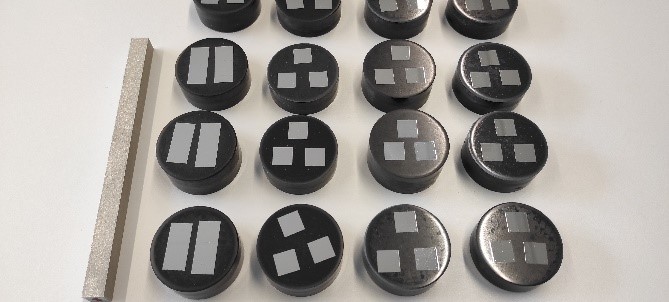News
Research Summary Report of A06
Category: Research Summary Report
Laser Powder-Bed Fusion (LPBF) of Steel Elements for Construction – Basics of Design and Mechanical Resilience. [12.05.2023] Diller, Johannes; Doctoral researcher; johannes.diller@tum.de, Siebert, Dorina; Doctoral researcher; dorina.siebert@tum.de Technical University of Munich, Chair of Metal Structures Wenzler, David; Doctoral researcher; david.wenzler@tum.de Technical University of Munich, Institute for Machine Tools and Industrial Management Summary The project A06 aims to explore and evaluate the factors influencing the manufacturing of safe and durable structural steel elements by Powder Bed Fusion of Metals using a Laser Beam (PBF-LB/M). Thereby, the PBF-LB/M process, the post-treatment, and the geometrical aspects in terms of microstructure and mechanical properties were investigated and correlations determined. In the first funding period, it is focused on analyzing small-scale specimens …
Zukunftstag beim AMC
Der dfg-geförderte Sonderforschungsbereich Additive Manufacturing in Construction blickt auf einen erfolgreichen Zukunftstag 2023 zurück. Wir haben Schülerinnen eingeladen, um sich über die Möglichkeiten und Herausforderungen des 3D-Drucks im Bauwesen zu informieren und ihnen eine praktische Einführung in diese Technologie zu geben. Es war ein aufregender Tag, an dem die Schülerinnen nicht nur die Grundlagen des 3D-Drucks kennenlernten, sondern auch unsere fortschrittlichen 3D-Drucker in Aktion erleben konnten. Wie wird Digitalisierung und 3D-Druck im Bauwesen eingesetzt? Wie gestaltet man in einem digitalen Prozesse Bauwerke? Und wie können neue Technologien dafür eingesetzt werden schneller, kosteneffizienter und nachhaltiger zu bauen. Wir waren beeindruckt von der Begeisterung und dem Engagement der Schülerinnen, die aktiv an den praktischen Workshops teilgenommen haben. Wir hoffen, dass wir ihnen …
Research Summary Report of A04
Category: Research Summary Report
Integrated Additive Manufacturing Processes for Reinforced Shotcrete 3D Printing (SC3DP) Elements with Precise Surface Quality [21.03.2023] Robin Dörrie; phd candidate, r.doerrie@tu-braunschweig.de, Technische Universität Braunschweig, Institute of Structural Design Main goal Within this project, basic research on various Shotcrete 3D Printing (SC3DP) strategies, materials, tools and methods will be conducted with regard to enhanced material and process control, reinforcement integration, surface quality and automation. To that end, different reinforcement materials in combination with suitable reinforcement manufacturing and integration concepts will be investigated based on force-flow oriented reinforcement alignment. Besides, design strategies as well as material and process control will be researched in detail. Furthermore, tools and strategies for precise control of the surface quality and geometric resolution of SC3DP elements …
3D Pioneers Challenge 2023 – Force Flow oriented Fibre Placement for AMC
3D Pioneers Challenge 2023 – Force Flow oriented Fibre Placement for AMC The AMC related process – “Force Flow oriented Fibre Placement for Additive Manufacturing in Construction” made it to the final round of the 3D Pioneers Challenge 2023! What a fanatastic achievement for our researchers Stefan Gantner, Philipp Rennen, Tom Rothe, Christian Hühne and Norman Hack. We are thrilled and incredibly excited! The project will be exhibited at Rapid.Tech3D from 09 -11 May at Messe Erfurt, Germany. Check out the 3D Pioneers Website: www.3dpc.io For more information about the project: https://amc-trr277.de/projects/project-area-a/focus-area-project-a05/ Braunschweig/München, April, 26th 2023 __________________________________________________ Contact: Meike Bährens M.A. PR & Kommunikations Koordinatorin / PR & Communication Coordinator Tel.: +49 531 391-3579 | Mobil: +49 …
Research Summary Report of B04
Category: Research Summary Report
Process Control and Adaptive Path Planning for Additive Manufacturing Processes Based on Industrial Robots with an Extended Degree of Freedom [14.04.2023] Lachmayer, Lukas; Doctoral researcher, lachmayer@match.uni-hannover.de, Leibniz Universität Hannover, Institute of Assembly Technology (match) Main goal The main objective of project B04 is to achieve repeatability in concrete-based robot-guided additive manufacturing processes, which is crucial for enhancing productivity, sustainability and safety in the construction industry. While additive manufacturing processes offer several benefits such as reduced workload, decreased material usage, and minimized manual labor, the time- and environment-dependent material properties of fresh concrete can lead to unpredictable outcomes and component collapses. By achieving stability and accuracy in these processes, we can ensure consistent and predictable results, thereby increasing minimizing the …
Research Summary Report of A03
Category: Research Summary Report
Extrusion of Near-Nozzle Mixed Concrete –Individually Graded in Density and in Rate of 3D Fibre Reinforcement [07.04.2023] Hechtl, Christian Maximilian, TP editor, m.hechtl@tum.de, TUM, Chair of Materials Science and Testing (cbm) Dr.-Ing. Kränkel, Thomas, PL, thomas.kraenkel@tum.de, TUM, cbm Prof. Dr.-Ing. Gehlen, Christoph, PL, gehlen@tum.de, TUM, cbm Main goal The goal of A03 is to establish a concrete extrusion process using a near-nozzle mixing (NNM) approach to enable a quick change of material properties during printing (gradation). This approach allows for the creation of multifunctional components, such as combined load-bearing and thermally insulating structures, by precisely altering material properties as required throughout the printing process. Summary and current state of research GRES V1 is a gradation-capable extrusion system that demonstrates …
AMC goes fair trade
The DFG-funded Collaborative Research Centre TRR 277 Additive Manufacturing in Construction (AMC) will present its innovative research with a stand and will be represented by Prof. Dr. Dirk Lowke with a presentation at BAU 2023, the leading trade fair for the construction industry. From Monday, 17th April to Saturday, 22nd April, the world’s leading trade fair BAU 2023 will open its doors and the AMC will be there. With its own stand in the “Innovation hub” Hall B0, the AMC will showcase research results achieved so far. Visitors to the trade fair will be able to get a tangible and comprehensible demonstration of the innovative power of 3D printing for the construction industry on the basis of a large number …
Research Summary Report of A02
Category: Research Summary Report
Particle-Bed 3D Printing by Selective Cement Paste Intrusion (SPI) – Particle Surface Functionalisation, Particle Synthesis and Integration of WAAM Reinforcement [24.03.2023] Straßer, Alexander, TP editor, alexander.strasser@tum.de, TUM, Chair of Materials Science and Testing Kränkel, Thomas, TP editor, thomas.kraenkel@tum.de, TUM, Chair of Materials Science and Testing Gehlen, Christoph, PL, gehlen@tum.de, TUM, Chair of Materials Science and Testing Main goal The goal of A02 is to implement reinforcement by Wire and Arc Additive Manufacturing (WAAM) in concrete elements produced by Selective Paste Intrusion (SPI), see Figure 1. Since the cement paste is applied to the aggregates and must penetrate the cavities between the aggregates by gravity, consistent rheological properties of the cement paste are essential. The welding process with WAAM generates …
Faszination Forschung: TUM Research Highlights
Ich bau’ dir ein Schloss mit Sand: Digitale Transformation auf der Baustelle 3D printing is changing the construction sector. Digital, resource-saving, fast and, above all, new freedom in shaping and design are key advantages of additive manufacturing. AMC TRR 277 scientists Kathrin Dörfler and Christoph Gehlen talk about it in the latest issue of Faszination Forschung, TUM. You can read the article under the following link: (page 36 ff.) https://mediatum.ub.tum.de/doc/1701891/1701891.pdf#p31 Braunschweig/München, March, 29th 2023 __________________________________________________ Contact: Meike Bährens M.A. PR & Kommunikations Koordinatorin / PR & Communication Coordinator Tel.: +49 531 391-3579 | Mobil: +49 171 389 5358 E-Mail: m.baehrens@tu-braunschweig.de | www.amc-trr277.de About the AMC: The Collaborative Research Center Transregio TRR 277 Additive Manufacturing in Construction (AMC) …
Research Summary Report of A01
Category: Research Summary Report
Particle-Bed 3D Printing by Selective Cement Activation (SCA) – Particle Surface Functionalisation, Particle-Bed Compaction and Reinforcement Implementation [10.03.2023] Herding, Friedrich; Researcher, f.herding@ibmb.tu-bs.de Mai, Inka; Researcher, mai@tu-berlin.de Lowke, Dirk; Project leader, d.lowke@ibmb.tu-bs.de TU Braunschweig, Institute of Building Materials, Concrete Construction and Fire Safety (iBMB) The main objective of our research is to understand the material-process interactions in particle-bed 3D printing (PB3DP) by Selective Cement Activation (SCA) in order to produce concrete elements with high mechanical strength and geometric precision. Besides, we are also investigating different ways of reinforcement integration, which is crucial for the manufacturing of load-bearing building components. Summary In particle-bed 3D printing by Selective Cement Activation the particle-bed consists mainly of a mixture of sand and …
Research Summary Report of C05
Category: Research Summary Report
Jointing Principles for Combination of Concrete Elements Produced by Different Additive Manufacturing Processes [24.03.2023] Prof. Dr. Martin Empelmann (iBMB) Prof. Dr. Harald Kloft (ITE) Abtin Baghdadi, a.baghdadi@tu-braunschweig.de Jan-Paul Lanwer, Hendrik Weigel (iBMB) The Technical University of Braunschweig, Institute of Structural Design (ITE) Institute of Building Materials, Concrete Construction and Fire Safety (iBMB) This collaborative project between ITE and iBMB (Concrete-Construction Division) focuses on investigating the combination of different additively manufactured elements using subtractive robotic processes. The primary objective of this project is to examine the jointing principle to determine the execution process and the load-bearing capacity of concrete joints, utilizing several concrete printing techniques for prefabricated structures. Specifically, the research in C05 explores the potential application of post-processing …
Research Summary Report of B03
Category: Research Summary Report
Modelling and Simulation of Shotcrete 3D Printing (SC3DP) Based on a Massively Parallel Multi-Phase, Multi-Component Coupled LBM-DEM Approach [17.03.2023] K. Kutscher (PostDoc), kutscher@irmb.tu-bs.de M. Geier (PI), geier@irmb.tu-bs.de M. Krafczyk (PI), kraft@irmb.tu-bs.de TU Braunschweig, IRMB The primary aim of the project is to understand and quantify the dynamic distribution of material components (fluid, air and particles) and kinetic energy inside the jet of liquid concrete present in the shotcrete process. The information is required as a basis for future optimization of the process with regards to process and material parameters as well as for the prediction of material inhomogeneities. Summary For the modeling of the shotcrete process, the project currently proceeds with the development of several model components. The coupling …
Research Summary Report of C04
Category: Research Summary Report
Integrating Digital Design and Additive Manufacturing through BIM-Based Decision Support and Digital Twin Methods [17.02.2023] Borrmann, André, Project leader,andre.borrmann@tum.de, Slepicka, Martin, Researcher,martin.slepicka@tum.de, Technical University of Munich,Chair of Computational Modeling and Simulation Summary Computer Aided Manufacturing (CAM) methods, such as Additive Manufacturing (AM), are becoming increasingly popular in the construction industry since they offer more geometrical freedom than conventional methods. However, more complex data preparation is required for these methods and thus they have been considered separately from digital design so far. To increase the usefulness of AM for the industry, this project aims to integrate AM methods into the digital design methodology BIM. To achieve this, a framework is being implemented that acts as an intermediate layer between design …
Research Summary Report of A02
Category: Research Summary Report
Particle-Bed 3D Printing by Selective Cement Paste Intrusion (SPI) – Particle Surface Functionalisation, Particle Synthesis and Integration of WAAM Reinforcement [10.02.2023] Hamilton, Leigh Duncan; Researcher; Leigh-Duncan.Hamilton@tu-braunschweig.de Zetzener, Harald; Leading researcher; H.Zetzener@tu-braunschweig.de Kwade, Arno; Project leader; A.Kwade@tu-braunschweig.de All: TU Braunschweig, Institute for Particle Technology Our main goal within project A02 is to unite two additive manufacturing (AM) processes, thereby, creating a hybrid AM process for structural concrete. The foundation of A02 is formed around the concrete 3D printing process Selective Paste Intrusion (SPI). SPI creates components in layers by first spreading coarse aggregates (usually quartz) on a surface or previous layer. Subsequently, the cement slurry is applied onto designated areas, where it fills void volumes between aggregate particles. The second …
Research Summary Report of A04
Category: Research Summary Report
Integrated Additive Manufacturing Processes for Reinforced Shotcrete 3D Printing (SC3DP) Elements with Precise Surface Quality [20.01.2023] David, Martin; Doctoral Researcher, m.david@tu-braunschweig.de, TU Braunschweig, Institute for Machine Tools and Production Technology (IWF) Summary Project A04 aims to investigate cooperative Additive Manufacturing (AM) processes based on Shotcrete 3D Printing (SC3DP) for the production of material-efficient, force-optimised, reinforced, load-bearing concrete components with precise surface quality and geometrical precision. The goal is to produce large-scale concrete elements using significantly lower amounts of reinforcement and concrete as compared to standard concrete construction principles. Hereby, different robot guided end effectors are subject for research in a flexible and automated process chain. Current state of research Currently, there are two focal points in the research …
Research Summary Report of A05
Category: Research Summary Report
Integration of Individualized Prefabricated Fibre Reinforcement in Additive Manufacturing with Concrete [03.02.2023] Rothe, Tom; Doctoral researcher, t.rothe@tu-braunschweig.de, Hühne, Christian; Project Leader, Christian.Huehne@tu-braunschweig.de, TU Braunschweig, Institute for Mechanics and Adaptronics (IMA) The individual integration of fibre reinforcement into large concrete components produced by Additive Manufacturing allows new design freedoms and reduces concrete consumption due to reduced concrete cover. The project A05 develops strategies to integrate freely formable reinforcement strands for the different AM processes. For doing so, a Dynamic Winding Machine is developed and constantly updated. This machine is used to consolidate and impregnate a primary fibre strand and wind a secondary yarn around it as a surface structuring. Thus, these reinforcement strands can be adapted for different purposes and …
Research Summary Report of A06
Category: Research Summary Report
Laser Powder-Bed Fusion (LPBF) of Steel Elements for Construction – Basics of Design and Mechanical Resilience [27.01.2023] Wenzler, David; doctoral researcher; david.wenzler@tum.de Technical University of Munich, Institute for Machine Tools and Industrial Management Diller, Johannes; doctoral researcher; johannes.diller@tum.de Siebert, Dorina; doctoral researcher; dorina.siebert@tum.de Technical University of Munich, Chair of Metal Structures Summary The project A06 aims to explore and evaluate the factors influencing the manufacturing of safe and durable structural steel elements by laser powder-bed fusion (LPBF). Thereby, the LPBF process, the post-treatment, and the influence of the part geometry on the microstructure and the mechanical properties will be investigated. From the results, correlations between these aspects will be determined. In the 1st funding period, the project …
Research Summary Report of A07
Category: Research Summary Report
Wire and Arc Additive Manufacturing (WAAM) of Complex Individualized Steel Components [13.01.2023] Jahns, Hendrik; Doctoral researcher; h.jahns@stahlbau.tu-braunschweig.de Unglaub, Julian; Principle Investigator; j.unglaub@stahlbau.tu-braunschweig.de Thiele, Klaus; Principle Investigator; k.thiele@stahlbau.tu-braunschweig.de Institute of Steel Structures Technische Universität Braunschweig In project A07 the design, manufacturing and mechanical properties of complex individualized WAAM steel nodes for use in construction is investigated. A new method is developed to design force flow optimized steel nodes as connectors between semi-finished parts and anchorage structures considering the manufacturing possibilities of the WAAM-process and the resulting material behaviour. The manufacturing possibilities will be identified by case study demonstrators, which represent occurring features of the designed node. The produced parts are characterized regarding their mechanical properties. For that an advanced material …
Research Summary Report of A08
Category: Research Summary Report
Structural Timber by Individual Layer Fabrication (ILF) [06.01.2023] Asshoff, Carsten; Doctoral researcher; carsten.asshoff@wki.fraunhofer.de Fraunhofer Institute for Wood Research Wilhelm-Klauditz-Institut WKI The main goal of the project ’A08 – Structural Timber by Individual Layer Fabrication (ILF)’ is to develop a process to additively manufacture large-scale, wood composite objects with a maximum content of wood material and strength values suited for applications in construction. In the course of the project multiple process variants and material combinations are explored. For this, the necessary machinery is developed in iterative steps and the mechanical properties of the resulting objects as well as the geometric capacity of the processes are investigated. Finally, multiple demonstrators are fabricated for showcase purposes. Summary Working group Bunzel is …
Research Summary Report of B04
Category: Research Summary Report
Process Control and Adaptive Path Planning for Additive Manufacturing Processes Based on Industrial Robots with an Extended Degree of Freedom [11.01.2023] Ekanayaka, Virama; Doctoral researcher, v.ekanayaka@tu-braunschweig.de, Hürkamp, André; Project Leader, a.huerkamp@tu-braunschweig.de, TU Braunschweig, Institute of Machine Tools and Production Technology (IWF) The integration of robot-guided additive manufacturing in the construction industry increases the degree of automation and can thus lead to an increased productivity and increased component quality. In shotcrete 3D printing (SC3DP), reproducible manufacturing results and ensuring component quality are major challenges, as the properties of shotcrete depend on many different parameters (e.g. temperature, pressure, water-cement ratio, hardening accelerator). The goal of this research project is to develop a reproducible, robot-guided shotcrete process based on multi-model adaptive path …





























